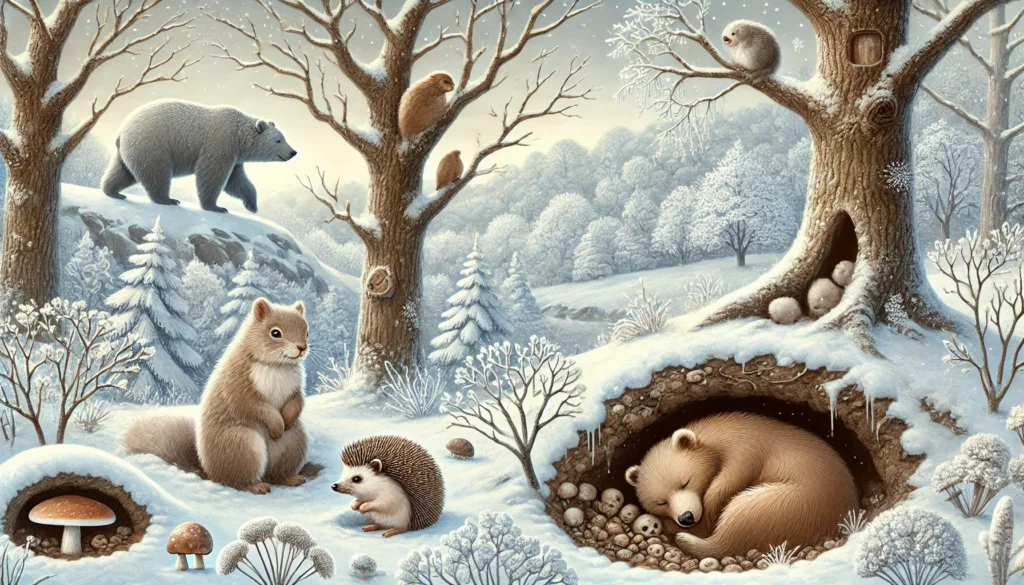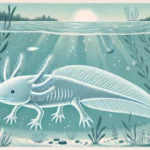Hibernation is a remarkable survival strategy that allows certain animals to endure the harsh conditions of winter by conserving energy and lowering their metabolic rates. During this period, their body temperature, heart rate, and breathing slow down significantly, helping them survive when food is scarce and temperatures drop. Here, we explore 10 animals that hibernate in the winter and the unique adaptations that enable them to enter this energy-saving state.
Bears: The Masters of Winter Sleep
Bears are among the most well-known hibernators, though technically, they enter a state known as torpor, rather than true hibernation. During torpor, a bear’s body temperature and metabolic rate drop, but not to the extent seen in smaller animals. Bears will typically remain in a deep sleep throughout the winter, often in dens or caves, living off the fat reserves they build up during the fall.
A key adaptation that allows bears to survive in this state is their ability to recycle body waste. Unlike true hibernators, bears do not eat, drink, or pass waste during torpor, yet their bodies can break down stored fat for energy while maintaining muscle mass. Mother bears also give birth during hibernation, and the cubs will nurse while the mother remains mostly inactive.
Hedgehogs: Small Mammals with Big Hibernation Needs
Hedgehogs are true hibernators, and they enter a deep, prolonged state of hibernation during the winter months. These small mammals prepare for winter by eating large amounts of food in the fall to build up fat reserves. As temperatures drop, hedgehogs retreat to burrows or other sheltered spots, where they will remain until spring.
During hibernation, a hedgehog’s body temperature can drop to match its surroundings, and its heart rate may slow to just a few beats per minute. This extreme reduction in bodily functions helps conserve energy, enabling the hedgehog to survive without food for months. If disturbed or the temperature rises briefly, hedgehogs may wake up, but they will typically return to hibernation once conditions stabilize.
Bats: Insect Eaters Turned Winter Sleepers
Many species of bats enter hibernation to survive the winter months, particularly those that feed on insects. In temperate regions, where insect populations dwindle during the winter, hibernation becomes essential for survival. Bats seek out caves, hollow trees, or even attics to hibernate, where the temperature remains cool but above freezing.
While in hibernation, a bat’s body temperature drops close to the surrounding environment, and its heart rate slows dramatically, from 200-300 beats per minute to as low as 10 beats per minute. Bats may awaken briefly during warmer spells, but they rely heavily on their fat reserves to make it through the winter. In some cases, hibernating bats may cluster together to retain warmth, further aiding their survival.
Groundhogs: Hibernation Experts
Groundhogs, also known as woodchucks, are true hibernators, and they are one of the few animals that enter a deep, long-term hibernation. These animals dig burrows underground, where they hibernate for several months, beginning in late fall and emerging in early spring. During hibernation, a groundhog’s body temperature can drop to near freezing, and its heart rate may slow to just 4-5 beats per minute.
To prepare for hibernation, groundhogs eat voraciously during the summer and fall, building up enough fat to sustain them through the winter. Their burrows provide insulation and protection from predators, and the hibernation process allows them to survive in regions where winter conditions make food inaccessible.
Turtles: Aquatic Hibernators
Certain species of turtles, such as the painted turtle, survive winter by hibernating underwater. Unlike land-based hibernators, aquatic turtles burrow into the mud at the bottom of ponds or rivers, where they enter a state called brumation, a form of hibernation seen in reptiles. During this time, their metabolism slows significantly, and they absorb oxygen through their skin to survive without breathing air.
Turtles rely on the oxygen levels in the water to sustain them through winter. If the water becomes too cold or oxygen levels drop too low, turtles may not survive hibernation. However, their ability to survive under ice in cold, oxygen-poor environments is a remarkable adaptation that allows them to endure the winter.
Snakes: Cold-Blooded Survivors
Many species of snakes hibernate during the winter months, especially in temperate regions. Being cold-blooded, snakes rely on external heat sources to regulate their body temperature. As winter approaches, snakes seek out underground burrows, caves, or other insulated areas where they can enter brumation.
Brumation is similar to hibernation but is unique to reptiles. Snakes become lethargic, their metabolism slows, and they stop eating for extended periods. Some species of snakes, like garter snakes, may brumate in large groups to conserve heat. This communal hibernation provides added protection against the cold, ensuring the survival of more individuals.
Frogs: Frozen but Alive
Certain frog species, such as the wood frog, have developed an incredible adaptation to survive winter. These frogs can freeze solid during the coldest months, with up to 65% of their body water turning to ice. During this time, the frog’s heart stops beating, and it effectively “shuts down” until spring.
To protect their cells from freezing, wood frogs produce high levels of glucose and other chemicals, which act as a sort of antifreeze. This prevents ice crystals from forming within their cells, allowing the frogs to thaw and resume normal activity once temperatures rise. This extreme form of hibernation is one of nature’s most remarkable survival strategies.
Squirrels: Energy Savers
Unlike true hibernators, squirrels enter a state called torpor, where they sleep for extended periods but can wake up when needed. Some species, such as the ground squirrel, do hibernate deeply, while others, like tree squirrels, simply reduce their activity and spend much of the winter sleeping.
Squirrels prepare for winter by storing food, such as nuts and seeds, which they bury in the ground or hide in tree crevices. During the winter months, they rely on these food caches to provide energy when they wake from torpor. Squirrels also have thick fur coats that help insulate them against the cold, allowing them to survive the winter without fully hibernating.
Ladybugs: Clustered Hibernate
Ladybugs, or ladybirds, are another group of animals that hibernate during the winter. These small insects gather in large groups, often seeking out warm, sheltered locations such as under tree bark, in cracks in walls, or inside buildings. Once they find a suitable spot, ladybugs enter diapause, an insect form of hibernation, where their metabolism slows down dramatically.
By clustering together, ladybugs conserve warmth and increase their chances of survival. When spring arrives, the ladybugs emerge from hibernation, ready to feed and reproduce. This social hibernation strategy allows them to survive the colder months when food, such as aphids, is scarce.
Common Poorwill: The Hibernating Bird
The common poorwill is the only known bird species that hibernates. This nocturnal bird, which is found in North America, enters a state of torpor during the winter when food becomes scarce. Unlike most birds, which migrate to warmer climates, the common poorwill conserves energy by lowering its body temperature and slowing its metabolism.
Poorwills hibernate in sheltered locations, such as rock crevices, where they can remain undisturbed for months. This ability to enter hibernation allows the common poorwill to survive in harsh, cold environments without having to migrate.
Conclusion
Hibernation is an extraordinary adaptation that allows animals to survive in environments where food is scarce and temperatures are freezing. From bears in torpor to frogs that freeze solid, these animals have evolved unique strategies to conserve energy and withstand the winter months. By entering states of hibernation, torpor, or brumation, these animals endure the most challenging season, only to emerge healthy and active when conditions improve.
FAQs
What is the difference between hibernation and torpor?
Hibernation is a prolonged state of inactivity where an animal’s body temperature, heart rate, and metabolism drop significantly. Torpor, on the other hand, is a short-term, temporary reduction in body functions that animals can enter and exit frequently. Torpor is more common in larger animals like bears.
Do all animals hibernate in the winter?
No, not all animals hibernate. Many animals remain active throughout the winter, while others enter states of reduced activity, like torpor or brumation. Hibernation is a survival strategy used by animals in colder regions where food becomes scarce.
How do animals prepare for hibernation?
Animals prepare for hibernation by consuming large amounts of food in the fall to build up fat reserves. These fat stores provide the necessary energy to sustain the animal throughout the hibernation period when they cannot eat or drink.
Can animals wake up during hibernation?
Yes, some animals may wake up during hibernation, especially if temperatures rise briefly or they are disturbed. However, most hibernating animals remain inactive and conserve energy until the weather improves.
How long does hibernation last?
The length of hibernation varies depending on the species and environmental conditions. Some animals hibernate for several months, while others may only enter a brief period of dormancy.
What happens to an animal’s body during hibernation?
During hibernation, an animal’s body temperature drops significantly, its heart rate slows, and its metabolism decreases. This helps the animal conserve energy, allowing it to survive without food or water for extended periods.


